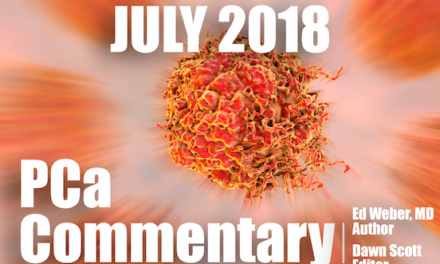
PCa Commentary | Volume 134 – May 2019
Posted by Edward Weber | May 2019
RADIOLIGAND THERAPY – The “VISION” Protocol: A treatment opportunity for men with late-stage metastatic castration-resistant prostate cancer.
Radioligand therapy (RLT) – i.e. PSMA directed endoradiation with Lutetium-177 – has been developed to the extent that it is a realistic option for men with late-stage, heavily pretreated, metastatic castration-resistant prostate cancer. The national protocol sponsored by Endocyte is open for enrollment at 66 sites in the United States. The June 2018 Commentary “Radioligand Therapy, An Update,” discussed the basic biology underlying this emerging treatment.
In brief, the treatment involves the intravenously administered radioactive isotope, Lutetium-177, joined with an antibody (identified as ‘617’) that targets the PSMA antigen expressed on the surface of nearly all cancerous prostate cells. It is internalized into the cell and emits lethal beta radiation over its 6.5 day half-life. The radionuclide concentrates around the cell nucleus and directly damages DNA. Among prostate cancer cells, there is a heterogeneity of intensity of PSMA expression, with best treatment results seen in men with the greatest PSMA expression.
This therapy has been extensively studied in many trials with the general consensus that the treatment is safe with minimal adverse effects and consistently has led to a >50% decline in PSA in a range of ~40 to 60% of the men. Three examples will be highlighted below.
➢ A typical example of study results were those published by Rahbar et al., “German Multicenter Study Investigating 177Lu-PSMA-617 Radioligand Therapy in Advanced Prostate Cancer,” J Nucl Med, 2017. Of the 145 men treated in 12 centers with 1-4 six week cycles, “the overall biochemical response rate was 45% (i.e. >50% decline in PSA) after all cycles, whereas 40% of patients had already responded after a single cycle.” Significant (i.e. grade 3-4) adverse effects were: anemia, 16%; reduced platelets, 4%; and low white blood cell counts, 3%. This represents fewer adverse effects than following second-line chemotherapy (e.g., most times cabazitaxel) and Radium-223 (Xofigo). Prior exposure to chemotherapy did not influence the likelihood of response.
Metastases in this study were present in bone, 87%; lymph nodes, 77%; liver 20%; and lung, 14%. Xerostomia, (dry mouth) was common, as the salivary glands exhibit the PSMA antigen. Predictors of poor response were visceral disease and elevation of the enzyme alkaline phosphatase, an indication of heavier bone involvement.
➢ The largest review of RLT was presented by Calopedos et al. Prostate Cancer and Prostatic Diseases, 2017. Ten trials were analyzed; 37% of 369 patients had a >50% decline in PSA. Their opinion: “PSMA-targeted RLT is a novel and promising concept, which provides a highly targeted systemic therapy for mCRPC, especially after exhausting [the available] conventional therapies.”
➢ The FDA’s approval of RLT incorporated into the ‘VISION’ protocol was based on the ASCO GU 2019 Symposium report by Hoffman et al. (Melbourne, Australia), based on the prospective LuPSMA treatment of 50 heavily retreated patients. A PSA decline of >50% occurred in 62%; in 44% the PSAs declined 80% or more; median survival after treatment, 13.3 months. The median overall survival in those men with a > 50% PSA response was 18 months vs those with a lesser PSA response, i.e. 8.7 months.
Adverse effects: Low grade dry mouth in 66%; anemia, 10%; decreased platelets, 8%; and low white blood cell count, 6%. Retreatment was offered to those responders who later progressed (n=14), and in this group the median overall survival was 33 months. The authors stated: “we recorded a rapid and clinically meaningful improvement in quality of life.”
Their conclusion was that their data “provides proof of concept that 177Lu-PSMA-617 has promising anti-tumor activity, low toxicity, and improves quality of life in patients with mCRPC who have not responded to most conventional treatment and exhibit high PSMA expression on PSMA PET/CT.” A multicenter Australian randomized phase 2 trial is ongoing comparing LuPSMA to cabazitaxel chemotherapy (NCT03392428) in men with very advanced disease.
The VISION Protocol (Clinicaltrials.gov, NCT03511664): “Study of 177Lu-PSMA-617 in Metastatic Castrate-Resistant Prostate Cancer.”
“The study population includes patients with progressive PSMA-positive mCRPC who received at least one novel anti-androgen axis drug (such as enzalutamide or abiraterone) and were previously treated with 1-2 taxane regimens.” The aim is to enroll 750 men. Participants are randomized in a 2:1 ratio between receiving the study treatment or ‘best supportive care’ as defined by their physicians. Six cycles of therapy at six-week intervals are planned with a re- evaluation after 4 cycles. Prior treatment with Xofigo (Rad-223) is an exclusion criteria. A pretreatment positive PSMA scan is a requirement. The primary objective of this study is to compare overall survival in the two cohorts.
The study is sponsored by Endocyte, the manufacturer of the study agent. The trial is currently available in 66 locations listed in the ClinicalTrial.gov web page. In the Western USA sites are recruiting in Arizona, California, and Colorado. The national study coordinator is Richard Messmann, MD, 765-476-1070, rmessmann@endocyte.com.
BOTTOM LINE:
In men undergoing treatment for metastatic CRPC, the effectiveness of current drugs targeting the androgen axis, e.g., abiraterone and enzalutamide, is limited by eventual resistance. An alternative therapy is clearly needed. Radioligand therapy such as 177Lutetium PSMA-617 is emerging as a safe and effective treatment. Participation in the VISION protocol offers a promising treatment opportunity for men at an advanced stage of the disease.
Your comments and requests for information on a specific topic are welcome e-mail ecweber@nwlink.com.
Please also visit https://prostatecancerfree.org/prostate-cancer-news for a selection of past issues of the PCa Commentary covering a variety of topics.
“I want to thank Dawn Scott, Staffperson, Tumor Institute Radiation Oncology Group, & Mike Scully, Librarian, Swedish Medical Center for their unfailing, timely, and resourceful support of the Commentary project. Without their help this Commentary would not be possible.”
ABOUT THE AUTHOR
Edward Weber, MD, is a retired medical oncologist living in Seattle, Washington. He was born and raised in a suburb of Reading, Pennsylvania. After graduating from Princeton University in 1956 with a BA in History, Dr. Weber attended medical school at the University of Pennsylvania. His internship training took place at the University of Vermont in Burlington.
A tour of service as a Naval Flight Surgeon positioned him on Whidbey Island, Washington, and this introduction to the Pacific Northwest ultimately proved irresistible. Following naval service, he received postgraduate training in internal medicine in Philadelphia at the Pennsylvania Hospital and then pursued a fellowship in hematology and oncology at the University of Washington.
His career in medical oncology was at the Tumor Institute of the Swedish Hospital in Seattle where his practice focused largely on the treatment of patients experiencing lung, breast, colon, and genitourinary cancer and malignant lymphoma.
Toward the end of his career, he developed a particular concentration on the treatment of prostate cancer. Since retirement in 2002, he has authored the PCa Commentary, published by the Prostate Cancer Treatment Research Foundation, an analysis of new developments in the prostate cancer field with essays discussing and evaluating treatment management options in this disease. He is a regular speaker at various prostate cancer support groups around Seattle.




